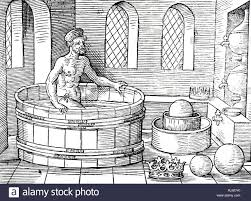Science > Physics > Units and Measurements > Measurement of Density
In this article, we shall study the measurement of the density of a substance.
Eureka! Eureka!
Archimedes was a Greek scientist. He lives in Syracuse nearly 200 years ago. The King of the land wanted to wear a Golden Crown. He gave some gold to a goldsmith to make a suitable crown. After a few days, the goldsmith brought the finished crown to the King. The crown was weighed. The weight of the crown was equal to the gold given to the goldsmith by the King. The King looked at the color of the crown. He had a suspicion. The goldsmith could have stolen some gold from the gold given to him. The King wanted to find out the truth. He asked his court scientist Archimedes to find out. The King said, “Find out how much gold had been stolen?”
How to find out the truth? Archimedes thought about the problem day and night. One day he was about to have his bath, but he was busy thinking. He did not notice the bathtub. The water in the bathtub was already full to the brim. He slid into the bathtub. Immediately a large quantity of water flowed over the brim of the bathtub. He noticed this suddenly. His brain wave worked suddenly. He jumped out of the bathtub, shouting, “Eureka! Eureka!” Eureka in Greek means “I have found it.” He proposed different metals of the same weight have different volumes. Objects, put in water, will displace water. The displaced water will be equal to their volume.

Archimedes took two bowls. He filled them with water to the brim. Then he placed each bowl separately in the middle of the large vessels. He placed the crown in one bowl. Water overflowed. It collected at the bottom of the outer vessel. Then he took a cube of pure gold. This cube of gold was equal in weight to the crown. He kept this gold cube in the middle of the second bowl. Here also water overflowed. Water got collected at the bottom of the outer bowl.
Archimedes then measured the quantity of water in the two vessels. He found out the difference in the water overflow. The crown had sent out more water. The cube of gold had sent out less water. But both the crown and the gold cube were of the same weight. So, they should have sent out the same quantity of water. Therefore, the crown had some other metals mixed in it. These metals took up more space in the water than pure gold.
Archimedes reported this finding to the King. The King demanded the truth from the goldsmith. The goldsmith then confessed. He had stolen some gold. He had added some other metals.
The Concept of Density:
Two substances having the same mass can occupy different volumes due to the difference in their densities or two substances having the same volume can have different masses. For example oil (density 800 kg/ m3) and water (density (1000 kg/ m3 ) have different densities, hence 1000 kg of oil occupies 1.250 m3 while 1000 kg of water occupies 1 m3. Similarly, 1 m3 of oil has mass 800 kg, while 1 m3 of water has mass 1000 kg. This behavior can be explained on the basis of the kinetic molecular theory. According to this theory, either of the following explanation is true.
- Perhaps the individual particles of oil and water each have the same mass, but in water, the particles are closely packed than those in oil. or
- Perhaps the individual particles of oil and water are equally spaced, but particles of water have more mass than those of the oil.
The property of matter that describes the relationship between mass and volume is called density. The density of a substance is defined as the mass of the substance per unit volume. It is denoted by letter’ or symbol (ρ) rho.
Mathematically.
Density = Mass/Volume
Its S.I. unit is kg m-3, c.g.s. unit is g cm-3. Sometimes the density of a liquid is expressed in g/litre.
Effect of Temperature on Density:
Most of the substances expand on heating and contract on cooling but their mass remains unchanged. Thus the density of substance decreases with an increase in temperature and it increases with a decrease in temperature.
But water below 4 oC behaves differently. When water is cooled below 4 oC water expands. Hence when water is cooled up to 4 oC, its density increases but below 4 oC it increases. This behaviour of water is called anomalous behaviour. Thus water has a maximum density at 4 oC.
Effect of Change of State on Density:
If the physical state of substance changes its density changes. For water (liquid) it is 1000 kg/ m3, for ice (solid) it is 900 kg/ m3 and for steam (gas) it is 0.59 kg/ m3 .
Factors Affecting Density:
- The space between particles of the substance
- The mass of the particle of the substance
- The temperature of the substance
Density of Mixture:
Numerical Problems:
Example – 01:
Mass of 2 m3 block of ice is 1800 kg. Find its density.
Given: Volume = V = 2 m3, Mass = M = 1800 kg
Solution:
Density = Mass/Volume = 1800/2 = 900 kg m-3
Ans: The density of ice is 900 kg m-3
Example – 02:
Mass of a block having length, breadth, and height 6 cm, 3 cm, and 2 cm respectively is 550.8 g. Find its density
Given: Length = 6 cm, breadth = 3 cm, height = 2 cm, Mass = M = 550.8 g
Solution:
Volume of block = length x breadth x height = 6 x 3 x 2 = 36 cm3
Density = Mass/Volume = 550.8/36 = 15.3 g cm-3
Ans: The density of material of block is 15.3 g cm-3
Previous Topic: Measurement of Mass and Weight
Next Topc: Measurement of Time